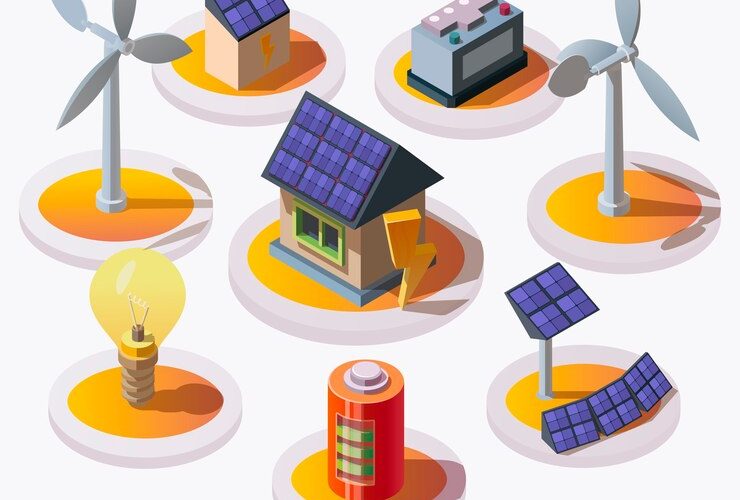As the world seeks to address the pressing challenge of climate change, the demand for renewable energy continues to rise. Governments, corporations, and individuals are all exploring ways to reduce their reliance on fossil fuels and shift towards more sustainable energy sources. The renewable energy sector has seen significant growth, with a 2023 report from Deloitte predicting a 17% increase in renewable energy usage in the United States by 2024, contributing to nearly a quarter of all electricity generation.
Renewable energy is more than just a trend—it’s a vital part of our fight against climate change. To understand how it plays a role in creating a more sustainable future, we need to explore the different types of renewable energy, their impact on the environment, and the growth of jobs within this field.
What is Renewable Energy?
Renewable energy refers to power derived from natural sources that are replenished faster than they are consumed. Common examples include sunlight, wind, geothermal heat, and water movement. These resources are abundant and, most importantly, are cleaner alternatives to fossil fuels like coal, oil, and natural gas, which are finite and contribute heavily to environmental degradation.
The Impact of Fossil Fuels

The burning of fossil fuels is a significant contributor to climate change. According to the U.S. Department of Energy (DOE), fossil fuels account for nearly 75% of carbon emissions over the past two decades. These emissions, primarily from coal, oil, and natural gas, release carbon dioxide and other harmful pollutants into the atmosphere, contributing to global warming.
As Dr. Hamed Majidzadeh, an environmental scientist, explains, transitioning to clean energy sources is essential to meeting global targets such as net-zero emissions by 2040. This shift is necessary to limit global warming to 1.5°C, the threshold for preventing the most catastrophic impacts of climate change.
Clean Energy vs. Renewable Energy
While “clean energy” and “renewable energy” are often used interchangeably, they aren’t exactly the same. Clean energy refers to energy sources that do not pollute the environment, such as solar or wind power. However, not all renewable energy sources are completely clean—some, like biofuels, can still have environmental impacts, including emissions from combustion.
Renewable energy, on the other hand, comes from naturally replenishing sources, even if the methods of harnessing it can have some environmental downsides. For example, solar and wind power are renewable, but the infrastructure required—such as solar farms and wind turbines—can affect local ecosystems.
The Five Main Types of Renewable Energy
There are several types of renewable energy, and they each play a critical role in moving towards a more sustainable energy future. Here are the five most common forms of renewable energy and their impact on the environment:
1. Solar Energy
Solar energy harnesses the power of the sun to generate electricity. Solar panels convert sunlight into electrical energy, making it one of the most widely used forms of renewable energy. Solar power is particularly versatile, from residential rooftops to massive solar farms.
In terms of renewable energy jobs, solar energy is the fastest-growing sector. According to the World Economic Forum (WEF), solar energy employed nearly 4.9 million people in 2022, accounting for more than one-third of all jobs in the renewable energy sector.
Environmental Impact: While solar power drastically reduces carbon emissions, large-scale solar farms require vast amounts of land, which can disrupt local ecosystems.
2. Wind Energy
Wind energy is harnessed through turbines that capture the kinetic energy of wind. These turbines are typically located in areas with high wind speeds, such as offshore or mountainous regions.
Wind energy, like solar, is a growing part of the clean energy sources movement, with both large-scale and smaller applications being used worldwide.
Environmental Impact: Wind turbines don’t produce emissions, but they do require large amounts of space and can sometimes harm wildlife, particularly birds.
3. Hydropower
Hydropower is one of the oldest and most widely used forms of renewable energy. It relies on the flow of water—usually rivers or dams—to generate electricity. According to the U.S. Office of Energy Efficiency and Renewable Energy (EERE), hydropower accounts for almost 29% of U.S. renewable electricity generation.
Environmental Impact: While hydropower doesn’t produce emissions, damming rivers can disrupt aquatic ecosystems and displace communities.
4. Geothermal Energy
Geothermal energy taps into the earth’s natural heat, using the breakdown of radioactive particles in the earth’s core to generate electricity or provide heating. This form of energy is highly reliable, as it isn’t dependent on weather conditions.
Environmental Impact: Geothermal energy has a relatively low environmental footprint, but drilling into the earth can lead to local environmental disturbances, including the release of greenhouse gases trapped beneath the surface.
5. Biofuels
Biofuels are renewable, organic materials used to generate energy. Common biofuels include ethanol (derived from corn) and biodiesel (from vegetable oils or animal fats). While biofuels are technically renewable, they aren’t always the cleanest option, as they require combustion, releasing emissions into the atmosphere.
Environmental Impact: Biofuels offer a renewable alternative to fossil fuels, but their production requires significant land and water resources, and burning them can still contribute to pollution.
The Future of Renewable Energy
As governments and industries transition from fossil fuels to more sustainable energy systems, renewable energy will play a pivotal role in creating a low-carbon future. The International Renewable Energy Agency (IRENA) reports that global jobs in the renewable energy sector grew from 7.3 million in 2012 to 13.7 million in 2022. The renewable energy systems industry is diverse, offering opportunities in fields such as solar panel installation, wind turbine maintenance, and environmental advocacy.
Career Opportunities in Renewable Energy

The growth of renewable energy has also opened up numerous job opportunities. The demand for workers spans various industries, from engineering and installation to environmental science and policy advocacy. For instance, solar energy jobs are booming, particularly as governments and businesses invest more in this technology.
Workers are needed to design, install, and maintain renewable energy systems such as wind turbines and solar panels. Environmental scientists are also in demand, particularly to help industries reduce their carbon footprint and develop more sustainable practices.
Challenges and Considerations
While renewable energy offers numerous benefits, challenges remain. One of the key issues is energy storage. Solar and wind energy, for example, are intermittent—they depend on the availability of sunlight or wind. Developing more efficient energy storage systems is crucial to ensuring a steady supply of power.
Additionally, energy efficiency and renewable energy systems must continue to evolve. It’s not just about producing clean energy but also using it more efficiently. Investing in energy-efficient technologies, such as smart grids and battery storage, will help to optimize the use of renewable resources.
Analysis Table: Environmental Impact of Different Types of Renewable Energy
| Type of Renewable Energy | Energy Source | Environmental Impact | Advantages | Disadvantages |
|---|---|---|---|---|
| Solar Energy | Sunlight | Large-scale solar farms require land and can disrupt ecosystems. Solar panel production has an environmental footprint. | Zero emissions during use, abundant energy source, scalable from small to large projects. | Land use concerns, initial installation costs, dependent on sunlight availability. |
| Wind Energy | Wind | Minimal emissions but can affect wildlife, particularly birds. Requires large areas for wind farms. | Clean, renewable, and produces no emissions. Can be implemented offshore. | Wildlife disruption, requires space, dependent on wind conditions. |
| Hydropower | Flowing water | Damming rivers affects aquatic ecosystems and displaces local populations. | Reliable energy source, low emissions once operational, suitable for large-scale energy needs. | Disrupts natural water flow, impacts fish populations, and alters local ecosystems. |
| Geothermal Energy | Earth’s heat | Low environmental impact, but drilling can release trapped greenhouse gases. | Reliable, stable energy source with minimal emissions. Not dependent on weather. | Limited to geologically active areas, potential for local environmental disruption. |
| Biofuels | Organic materials (e.g., plants, corn, animal fats) | Combustion of biofuels emits pollutants. Resource-intensive production process (land, water). | Renewable, reduces reliance on fossil fuels, can be produced locally. | Requires significant land and water resources, still contributes to air pollution when burned. |
Comparative Table: Key Factors of Different Types of Renewable Energy
| Factors | Solar Energy | Wind Energy | Hydropower | Geothermal Energy | Biofuels |
|---|---|---|---|---|---|
| Source of Energy | Sunlight | Wind | Flowing water | Earth’s internal heat | Organic materials |
| Energy Efficiency | Moderate | High | High | High | Moderate |
| Job Opportunities | High (solar panel installation, maintenance, engineering) | High (wind turbine maintenance, operation) | Moderate (dam construction, maintenance) | Moderate (plant operation, research) | Moderate (production, research) |
| Environmental Impact | Land use, minimal emissions | Wildlife impact, large land area needed | Disrupts aquatic ecosystems | Minimal environmental impact, low emissions | Emissions from combustion, resource-intensive |
| Suitability for Large-Scale Use | High | High | High | Moderate | Moderate |
| Dependence on Weather | High | High | Low | Low | Low |
| Energy Storage Challenges | Yes | Yes | Less challenging | No | Yes |
| Growth Potential | High | High | Moderate | Moderate | Moderate |
| Geographic Limitations | None | Needs windy locations | Needs rivers or water bodies | Geothermal active areas required | Agricultural or forested regions |
These tables provide an in-depth analysis and comparison of the types of renewable energy, highlighting their environmental impact, advantages, disadvantages, and other factors like job opportunities and growth potential.
Conclusion
The renewable energy sector is critical to addressing climate change and ensuring a sustainable future. From solar and wind power to geothermal and hydropower, these sources of renewable energy are helping to reduce our reliance on fossil fuels. However, it’s essential to continue investing in technological advancements to overcome challenges such as energy storage and land use.
As the industry grows, so do the opportunities for careers in renewable energy. According to the International Renewable Energy Agency, jobs in this sector are on the rise, and the field offers a promising future for those interested in contributing to environmental sustainability.
Ultimately, a combination of renewable energy systems will be needed to meet the world’s growing energy demands while reducing carbon emissions and minimizing environmental impacts.












